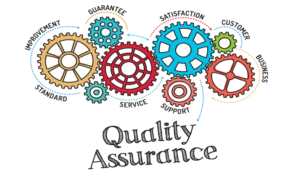In this blog, we summarize the key points from a recent article from David McGeough at Scorebuddy where he explored how automation and AI are transforming quality management in contact centres to meet modern demands.
Quality management is crucial for upholding service standards in contact centers, ensuring each interaction aligns with your expectations and that agents consistently perform well.
However, as communication channels expand beyond just phone calls and interaction volumes surge, maintaining quality has become increasingly complex.
To meet this growing demand and sustain high service levels, automating your quality management process is now essential. Fortunately, the rise in interaction volume has been matched by advancements in contact centre technology, particularly in automated quality management solutions.
But do we need artificial intelligence, automation, and all these fancy other tools to keep up with the modern demands of a contact centre? Let’s dive in and see what’s really going on.
The Problem with Traditional Quality Management
While the traditional approach to quality management is widely known, it’s far from perfect, particularly in today’s tech-driven world.
Several issues hinder its efficiency, accuracy, and overall performance in call centres. Understanding these challenges highlights the need for change in call centre operations.
Consumes Time and Resources
Traditional call centre quality assurance is time-consuming. Evaluators spend hours listening to call recordings, reviewing transcripts, taking notes, and compiling data, with a single evaluation often taking 20 minutes or more.
This manual process demands significant time and labor that could be better allocated elsewhere, like targeted coaching, QA data analysis, or strategic initiatives.
Difficult to Extract Useful Insights
Besides being time-intensive, traditional QA also struggles to provide comprehensive insights. Typically, only 2 to 3% of interactions are captured and analyzed, leaving a vast amount of data untapped.
This limited dataset makes it hard to get a true sense of performance, customer experience, or key metrics. Important trends may go unnoticed, making it tough to make informed decisions or track progress effectively.
Subject to Bias and Inconsistency
Human evaluators bring inherent subjectivity to the QA process, leading to inconsistent results. Different team members may interpret the same call differently, which can create bias and reduce the standardization of quality across interactions.
Consistency is key for an effective quality management system, but it’s hard to achieve when evaluations depend on individual perspectives.
Limited Scalability
As call centres grow, traditional QA methods struggle to keep up. Customer expectations are higher than ever, and tracking multiple channels manually becomes nearly impossible.
Manual reviews can become overwhelming as interaction volumes increase, forcing companies to either hire more evaluators (which is costly) or cut corners, risking the quality of the customer experience.
Risk of Compliance Failures Due to Human Error
Human error is inevitable in manual processes, leading to blind spots in QA. Even minor mistakes can have significant consequences, such as compliance breaches. With such a low sample size in manual QA, these risks increase as call volumes grow, making it harder to meet regulatory standards.
What is Automated Quality Management (AQM)?
Automated quality management leverages modern technology to monitor, evaluate, and improve call centre interactions. Unlike manual methods, AQM uses AI and machine learning to analyze every call, chat, email, and other communication in real-time.
This automation ensures complete coverage of all customer interactions, providing consistent and transparent evaluations while saving time. The benefits? Reduced human bias, more accurate evaluations, improved agent morale, higher service quality, real-time feedback, and stronger compliance.
How Does Automated Quality Management Work? The AI Behind It
Automated quality management transforms call centre operations through technologies like natural language processing (NLP) and machine learning (ML).
Natural Language Processing (NLP)
NLP enables computers to understand and analyze the language used in customer interactions, breaking down conversations to detect tone, sentiment, and key phrases. This helps assess communication quality and monitor compliance, making it easier to identify customer concerns and measure agent performance.
Machine Learning (ML)
ML focuses on pattern recognition and predictive analytics. By learning from the vast amount of data generated by call centres, ML algorithms improve over time, identifying trends and areas for improvement.
This allows for the refinement of training programs, optimization of call scripts, and prediction of future outcomes, creating a more efficient and personalized call centre.
Why Use Automated Quality Management in Your Contact Centre? 7 Key Benefits
Implementing AQM in your contact centre can vastly improve operations and customer experience. Here are seven reasons why it’s a smart investment:
- Streamline Your QA Process: AQM automates the evaluation of every customer interaction, saving time and money while ensuring consistency.
- Ensure More Accurate Evaluations: AQM delivers objective feedback based on predefined criteria, scaling to 100% interaction coverage for more reliable quality management.
- Provide Real-Time Feedback: AQM gives agents immediate insights and corrective suggestions during calls, allowing on-the-spot adjustments to avoid negative experiences.
- Personalize Coaching and Training: AQM identifies specific improvement areas for each agent, enabling tailored coaching that leads to better performance.
- Address Customer Pain Points: AQM analyzes trends in customer interactions, helping teams proactively address common issues and improve satisfaction.
- Boost ROI: By enhancing efficiency and accuracy, AQM reduces operational costs and improves service quality, leading to happier customers and better financial returns.
- Maintain Compliance and Audit Trails: AQM monitors 100% of interactions, flagging compliance risks and maintaining audit trails to ensure regulatory standards are met.
The 6 Most Important Features of an Automated Quality Management System
- Quality Assurance Auto Scoring: Automates the scoring of all interactions based on predefined criteria, covering 100% of interactions efficiently.
- Speech Analytics and Transcription: Transcribes voice conversations for analysis, capturing key insights to improve service.
- Sentiment Analysis: Identifies conversation sentiment to gauge satisfaction and address issues before they escalate.
- Keyword and Topic Detection: Detects trends within interactions, offering insights into customer concerns and script adherence.
- Analytics and Reporting: Provides data-driven insights into agent performance and operations, helping identify areas for improvement.
- Integration with Other Tools: Ensures seamless workflow by integrating with CRM, WFM, and other essential tools for a comprehensive understanding of the customer journey.
How to Implement Automated Quality Management in Your Call Centre: 6-Step Guide
- Identify Specific Needs: Determine where your current QA process falls short and set clear goals for automation.
- Choose the Right AQM Solution: Select a solution that aligns with your objectives and offers relevant features.
- Integrate with Existing Systems: Ensure the AQM system works seamlessly with your CRM, WFM, and other tools, starting with small pilot programs.
- Manage Change Effectively: Train your team and stakeholders to understand and embrace the new tools, easing the transition.
- Proactively Address Challenges: Anticipate potential obstacles and work with your vendor to tackle them before they disrupt progress.
- Ensure Data Security and Privacy: Choose a system that complies with industry regulations and offers robust security features to protect your data.
Conclusion
Manual quality management is no longer the best option for evaluating your contact centre’s performance. With modern technology, automated quality management offers superior efficiency, comprehensive coverage, and significant cost savings, making it the clear choice for a better ROI.
This blog post has been re-published by kind permission of Scorebuddy – View the Original Article
For more information about Scorebuddy - visit the Scorebuddy Website
Call Centre Helper is not responsible for the content of these guest blog posts. The opinions expressed in this article are those of the author, and do not necessarily reflect those of Call Centre Helper.
Author: Scorebuddy
Published On: 2nd Sep 2024 - Last modified: 22nd Oct 2024
Read more about - Guest Blogs, David McGeough, Scorebuddy






 Scorebuddy is quality assurance solution for scoring customer service calls, emails and web chat. It is a dedicated, stand-alone staff scoring system based in the cloud, requiring no integration.
Scorebuddy is quality assurance solution for scoring customer service calls, emails and web chat. It is a dedicated, stand-alone staff scoring system based in the cloud, requiring no integration. 





























